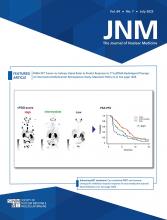TO THE EDITOR: We have read with great interest the results of the DESTINY-Breast04 trial, “Trastuzumab Deruxtecan in Previously Treated HER2-Low Advanced Breast Cancer,” from Modi et al. and published in The New England Journal of Medicine (1). These impressive findings have also earned a standing ovation after the plenary session presentation at the American Society of Clinical Oncology annual meeting in June 2022 and led to the Food and Drug Administration approval of a novel anti–human epidermal growth factor receptor-2 (HER2) therapy, trastuzumab deruxtecan (T-DXd), for the treatment of patients with HER2-low metastatic breast cancer (mBC) in August 2022. We strongly believe that the nuclear medicine community should be familiar with the results of this pivotal clinical trial, which is opening new, exciting prospects for HER2-targeted PET imaging.
HER2 is a membrane protein encoded by the ERBB2 oncogene. ERBB2 is amplified in 10%–15% of invasive breast carcinomas and classified as HER2-positive for clinical practice. These tumors are identified by immunohistochemistry both as being scored 3+ or 2+ and as having a gene amplification as assessed by fluorescence in situ hybridization. Until now, only HER2-positive breast cancers could be targeted by anti-HER2 therapies. The rest of the tumors have no detectable HER2 or low levels, with the patients known as, respectively, “HER2-zero” and “HER2-low” patients.
Within DESTINY-Breast04, T-DXd provided clinically meaningful benefits compared with standard chemotherapy in patients with HER2-low mBC. T-DXd successfully prolonged both progression-free survival and overall survival among patients with HER2-low mBC (1). Patients in the T-DXd group had a median progression-free survival of 10 mo, compared with a median progression-free survival of 5 mo in the chemotherapy group, and, thus, a 50% reduction in the risk of disease progression or death (hazard ratio, 0.50; 95% CI, 0.40–0.63; P < 0.0001).
The findings are necessarily changing the way advanced breast cancers are classified. We are rethinking the way of assessing the HER2 status. However, the current standard immunohistochemistry assays were not standardized to distinguish HER2-low from HER2-zero patients (2) but to identify HER2-positive patients. Pathologists are currently modifying their methods of interpreting the staining to identify HER2-low patients accurately. The question remains open, and whether the development of new strategies based on immunofluorescence or mass spectrometry currently under investigation would improve patients’ HER2 status assessment is under investigation (3). In a metastatic context, the HER2 status heterogeneity between metastatic sites remains challenging to assess and is known to impact response to therapies (4) and spatiotemporal intratumoral HER2 heterogeneity.
HER2 PET thus appears a promising alternative tool for monitoring whole-body HER2 expression quantitatively and noninvasively. Although most published studies focused mainly on HER2-positive patients (5,6), a critical paper by Ulaner et al. published in The Journal of Nuclear Medicine in October 2016 demonstrated that imaging with a HER2-targeted PET tracer can detect HER2-positive metastases in patients with HER2-negative primary breast cancer (7). Such interesting findings highlight that HER2 PET can identify additional candidates for HER2-targeted therapy, such as T-DXd.
However, in these studies, the authors used the cancer treatment drug trastuzumab, a monoclonal antibody that specifically binds to the HER2 protein, as the imaging agent (5–7). Although uptake of 64Cu-DOTA-trastuzumab in mBC is strongly associated with patient HER2 status (5), such HER2-targeted PET imaging does not assess strictly HER2 status but measures the uptake of trastuzumab, which provides pharmacokinetic information. Furthermore, as stated by Mortimer et al., 64Cu-DOTA-trastuzumab PET/CT could help determine which patients will respond to HER2-targeted therapy (6).
The development of specific radiotracers, including radiolabeled Affibody molecules (Affibody AB) (8,9) or single-domain antibodies (10), directly targeting the HER2 protein and enabling accurate assessment of the HER2 status is an area of intensive investigation within the nuclear medicine community. For example, by labeling the Affibody molecule with a radioactive tracer, such as 68Ga or 18F (9), it is possible to visualize the distribution and uptake of the tracer in cancer cells that express HER2. In addition, such novel radiolabeled Affibody molecules or single-domain antibodies could allow imaging within hours of tracer administration and reduce radiation dose to patients.
Finally, none of these studies specifically looked at HER2-low patient populations, and such studies now need to be deepened and sustained, given the results of the DESTINY-Breast04 trial.
First, whereas patients with HER2-zero mBC are not eligible for T-DXd, HER2 PET could allow visualization of lesions with low HER2 expression in these patients, making them potentially eligible for T-DXd. Second, HER2 PET could eventually become a predictive marker of T-DXd efficacy among patients who are currently eligible for this treatment and identify those who do not benefit from T-DXd: in DESTINY-Breast04, up to 30% of patients experienced disease progression within the first 6 mo of T-DXd therapy, although their tumor was classified as HER2-low by immunohistochemistry (1). Such a biomarker could prove its clinical utility in the context of new treatments becoming available targeting other membrane antigens, such as tumor-associated calcium signal transducer 2.
In conclusion, the DESTINY-Breast04 findings have revolutionized the therapeutic strategy for HER2-low mBC patients and also raised several questions about determining HER2 status. HER2 PET imaging is a serious candidate modality that may provide most of these answers and could become the novel cornerstone of therapeutic decisions. The next step is to pursue clinical studies that would ensure a deeper understanding of how HER2 PET could be used as a clinical decision-support tool in patients with HER2-low mBC treated with novel HER2-targeted therapies, as well as T-DXd.
DISCLOSURE
Francois-Clement Bidard received research grants from GE Healthcare and Astra-Zeneca and advisory board honoraria from GE Healthcare, Astra-Zeneca, and Daichii-Sankyo. No other potential conflict of interest relevant to this article was reported.
Romain-David Seban,* Laurence Champion, Audrey Bellesoeur, Anne Vincent-Salomon, Francois-Clement Bidard
*Institut Curie, Saint-Cloud, France
E-mail: romaindavid.seban{at}curie.fr
Footnotes
Published online May 25, 2023.
- © 2023 by the Society of Nuclear Medicine and Molecular Imaging.
REFERENCES
- Received for publication February 13, 2023.
- Revision received March 14, 2023.







